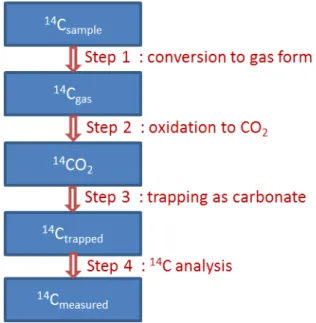HAL Id: cea-02506804
https://hal-cea.archives-ouvertes.fr/cea-02506804
Submitted on 12 Mar 2020HAL is a multi-disciplinary open access
archive for the deposit and dissemination of sci-entific research documents, whether they are pub-lished or not. The documents may come from teaching and research institutions in France or abroad, or from public or private research centers.
L’archive ouverte pluridisciplinaire HAL, est destinée au dépôt et à la diffusion de documents scientifiques de niveau recherche, publiés ou non, émanant des établissements d’enseignement et de recherche français ou étrangers, des laboratoires publics ou privés.
Carbon 14 distribution during spent fuel dissolution
-Application to an UOx3 spent fuel
M. Crozet, G. Ferlay
To cite this version:
M. Crozet, G. Ferlay. Carbon 14 distribution during spent fuel dissolution - Application to an UOx3 spent fuel. GLOBAL 2015, Sep 2015, Paris, France. �cea-02506804�
Carbon 14 distribution during spent fuel dissolution
Application to an UOx3 spent fuel
M. Crozet; G. Ferlay
CEA Nuclear Energy Division, Marcoule Center Radiochemistry & Processes Department, Laboratory of Dissolution Studies
F-30207 Bagnols sur Cèze Cedex, France
Carbon 14 (14C) is a radionuclide formed during the irradiation of nuclear fuel, primarily from
nitrogen 14, impurity present in the fuel, and from oxygen 17 present in oxide matrix. One of the objectives related to this radionuclide concerns the knowledge of its distribution in the different flows during the spent fuel dissolution, some of which contribute to the wastes of the plant. These flows are gases emitted during the dissolution, unclarified dissolution solution and hulls. In 2013-2014, an essay program offering quantification of 14C in each of
these flows during nitric dissolution was proposed and applied: around 51 grams of a 53.1 GWd/tHM UOX3 spent fuel were involved in the essay. The block diagram of the conducted
Figure 1 : Block diagram of the essay of 14C measurement in the different flows generated during spent fuel dissolution
Measurement principle: Whatever the material of which one wants to determine the 14C
content, the principle of 14C analysis method is currently almost always the same. This is to
pass the 14C in the gas form then converting it to carbon dioxide to trap as carbonate in a
sodium hydroxide solution, which solution is then analyzed by β scintillation (Figure 2). Each step must be quantitative or with a known yield.
Figure 2 : Measurement principle of 14C in a material
Gas flow: The 14C activity measured in the gas flow emitted during this spent fuel dissolution
(on conditions closed to the current plant ones and before trapping) is approximately 580,000 Bq that is to say 11,300 Bq /g of spent fuel (in this work, by spent fuel, it is understood the entire fuel section involved, oxide and clad), about 13,400 Bq / g of oxide. Hulls flow: The amount of 14C measured in hulls corresponds to an activity of 195 000 Bq for the overall essay and thus to 3,800 Bq / g of spent fuel.
Unclarified dissolution solution: The amount of 14C measured in the unclarified spent fuel
dissolution solution corresponds to an activity of 666,000 Bq for the essay, and thus to 12,900 Bq / g of spent fuel.
The total 14C activity measured in the Cruas (53.1 GWd / tHM) UOX3 fuel section dissolved in
conditions closed to those of the current plant is 1,441,000 Bq corresponding to about 51 g of spent fuel dissolved that is 28,000 Bq / g of spent fuel (oxide and clad). Under these spent fuel dissolution conditions, 40% of 14C present in the UOx3 dissolved section are measured in
the emitted gas during the spent fuel dissolution, 46% are measured in the unclarified dissolution solution and 14% are measured in hulls. This essay is the first measurement of
